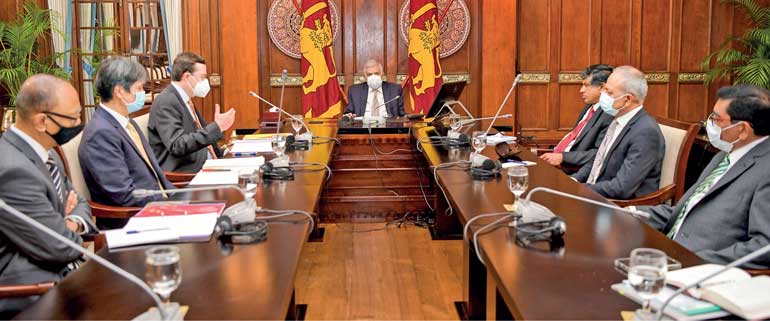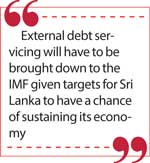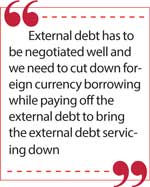Monday Apr 21, 2025
Monday Apr 21, 2025
Friday, 5 April 2024 00:26 - - {{hitsCtrl.values.hits}}

President Ranil Wickremesinghe chairs a meeting with the IMF in Colombo – File photo
 In my opinion, the IMF program Sri Lanka has got now is lenient when you compare it with many other countries. The 17th IMF program may not be enough even if implemented fully. Therefore, there is very little space to make changes in the broader program targets.
In my opinion, the IMF program Sri Lanka has got now is lenient when you compare it with many other countries. The 17th IMF program may not be enough even if implemented fully. Therefore, there is very little space to make changes in the broader program targets.
The 3 broad targets of Sri Lanka’s 17th IMF program -
1.Achieve a primary budget surplus of 2.3% by 2025 and beyond
2.Bring annual foreign currency debt service from 9.4% of GDP in 2022 to 4.5% of GDP during 2027-2032. Reduce the government’s gross financial needs which was at 35% of GDP in 2022 down to below 13% from 2027-2032.
3.Public debt, which was 128% to GDP, should be reduced to 95% by 2032.
If there were to be any renegotiations of the IMF deal by a future government, it will have to change one or all of the above. Let me go through them one by one.
Target 1 - Primary budget surplus of 2.3% by 2025 and beyond
Sri Lanka has just achieved a primary budget surplus of 1.2% for the year 2023 which means excluding the interest payments, we have recorded a fiscal surplus of 1.2%. But the budget deficit for 2023 was 7.1% of GDP which is quite high. As the government is shut out of international capital markets and cannot print money with the New Central Bank Act taking effect, the government borrows from the domestic market along with multilateral funds. When Sri Lanka’s debt is over 100% of GDP and government revenue to GDP is one of the lowest in the world (around 8% in 2022), running a 7% budget deficit is not sustainable. Even if Sri Lanka was to have achieved the primary budget surplus of 2.3% in 2023, we would still have had a 6% budget deficit which is still unsustainable. By trying to renegotiate with the IMF to make the first target of achieving a primary budget surplus of 2.3% more lenient, the Sri Lankan government is basically trying to renegotiate with the IMF to allow Sri Lanka to have a larger budget deficit. When the current budget deficit of 7.1 (2023) itself is unsustainable, a large fiscal deficit is unsustainable and will only cause long term damage to Sri Lanka by increasing Sri Lanka’s debt burden.
Target 2 - External Debt servicing to 4.5% of GDP for 2027-2032
In 2022, the external debt servicing was 9.4% of GDP which is not sustainable. The IMF target is to bring it down to 4.5%. Sri Lanka’s external debt is over $50 billion. External debt servicing will have to be brought down to the IMF given targets for Sri Lanka to have a chance of sustaining its economy. Since Sri Lanka defaulted in 2022, Sri Lanka is not paying any foreign debt (except multilateral debt) and has banned importing vehicles, but still its current account balance is estimated to be barely positive at 1.5% (according to IMF country report Dec 2023). Yet again, Sri Lanka has almost no room to renegotiate the IMF program here. External debt has to be negotiated well and we need to cut down foreign currency borrowing while paying off the external debt to bring the external debt servicing down. This will require closing the trade deficit. Sri Lanka’s current account deficit was 5.4% of GDP for 2023 even when debt repayments to bilaterals and bondholders is suspended. Trying to renegotiate this target will only damage Sri Lanka in the long term.
 Target 3 - Government debt to 95% by 2032
Target 3 - Government debt to 95% by 2032
When Sri Lanka defaulted in 2022, its debt to GDP was at 128%. Even if we successfully complete the IMF program, our debt is only expected to come down to 95% of GDP by 2032. Ghana declared bankruptcy when its debt to GDP was only around 92%. So even if we successfully complete the IMF program, our debt to GDP ratio will still be worse than the debt level at which Ghana defaulted. Let me repeat so it is clear. So, we are trying our best through the IMF program, so that 8 years later we can get to a level of debt to GDP which would still be worse than at which Ghana defaulted. The other part is that when Ghana defaulted with its debt at around 92% of GDP, its government revenue to GDP was 14%. Sri Lanka’s was at less than 8% when it defaulted. Yet, the IMF was much harsher on Ghana than it has been on Sri Lanka.
Is there space to renegotiate the IMF program?
If we are to renegotiate the IMF program to make it easier, where are we going to make the changes? Do we renegotiate the IMF program to make things easier in the short term which will result in our debt to GDP level being over 95% in 2032? Remember Ghana defaulted at around 92% of debt to GDP only. In that case we are walking straight into another default which will be even worse than our first default in 2022. If we default again, the debt negotiations with the bilaterals and bondholders will be much tougher. They will demand tougher reforms and faster. If we default again, we have to go to the IMF once again, and the IMF program would be much harsher, and rightly so. Of course, we can negotiate with the IMF for smaller changes in the details of this IMF program, but nothing big can be renegotiated as there is no space for change. Once again to reiterate, even if we complete this IMF program, we are expected to bring down the debt to GDP down to 95% which is still worse than the debt level at which Ghana defaulted at only around 92% of debt to GDP.
 So, I do not see any space to make large and meaningful changes to the current IMF program by a future government though the way the targets are to be achieved at the smaller level can be renegotiated. It is like a cancer patient trying to negotiate with his doctor to reduce the frequency of chemotherapy from once every week to once every month. If the doctor agrees and lightens the cancer treatment, it is the patient’s life that is at greater risk. If Sri Lanka still tries to negotiate with the 17th IMF program to make it more lenient through large changes, it will only be to its own detriment.
So, I do not see any space to make large and meaningful changes to the current IMF program by a future government though the way the targets are to be achieved at the smaller level can be renegotiated. It is like a cancer patient trying to negotiate with his doctor to reduce the frequency of chemotherapy from once every week to once every month. If the doctor agrees and lightens the cancer treatment, it is the patient’s life that is at greater risk. If Sri Lanka still tries to negotiate with the 17th IMF program to make it more lenient through large changes, it will only be to its own detriment.
(The author is an Economist. He is currently a Consultant on economic policy for a global multilateral development bank. He is an expert member of the World Economic Forum and he is a regular columnist for the International Monetary Fund on public finance management. He was a member of the Deloitte Global Economist Network. The views expressed in this article are strictly the author’s own personal opinions.)